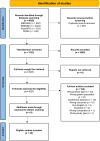Cardiovascular disease, associated risk factors, and risk of dementia: An umbrella review of meta-analyses
- PMID: 38455934
- PMCID: PMC10910908
- DOI: 10.3389/fepid.2023.1095236
Cardiovascular disease, associated risk factors, and risk of dementia: An umbrella review of meta-analyses
Abstract
Introduction: Cardiovascular diseases (CVDs) have been associated with an increased risk of dementia; yet the evidence is mixed. This review critically appraises and synthesises current evidence exploring associations between dementia risk and CVD and their risk factors, including coronary heart disease, heart failure, atrial fibrillation, hypertension, hyperlipidaemia, and arterial stiffness.
Methods: MEDLINE, Embase, PsycINFO, and the Cochrane Database of Systematic Reviews were searched to identify systematic reviews with meta-analyses investigating the association between at least one of the CVDs of interest and dementia risk. The Joanna Briggs Institute (JBI) Critical Appraisal Checklist for Systematic Reviews was used to assess methodological quality.
Results: Twenty-five meta-analyses published between 2007 and 2021 were included. Studies largely consisted of cohorts from North America and Europe. Findings were variable, with coronary heart disease, heart failure, and atrial fibrillation consistently associated with increased risk for all-cause dementia, but results were inconsistent for Alzheimer's disease. Hypertension was more frequently associated with dementia during mid-life compared to late life. Findings concerning cholesterol were complex, and while results were inconsistent for low-density lipoprotein cholesterol and total cholesterol, there appeared to be no associations between triglycerides and high-density lipoprotein cholesterol. All meta-analyses investigating hypercholesterolaemia showed significant increases in dementia risk. There was a paucity of research on the association between arterial stiffness and dementia risk.
Conclusion: Targeted CVD dementia prevention strategies could reduce dementia prevalence. Future research should determine the underpinning mechanisms linking heart and brain health to determine the most effective strategies for dementia risk reduction in CVD populations.
Keywords: cardiovascular disease; dementia; dementia risk; epidemiology; protective factor; risk factors; umbrella review.
© 2023 Brain, Greene, Tang, Louise, Salter, Beach, Turnbull, Siervo, Stephan and Tully.
Conflict of interest statement
The authors declare that the research was conducted in the absence of any commercial or financial relationships that could be construed as a potential conflict of interest.
Figures










References
-
- World Health Organization. Dementia - key facts report: World Health Organisation (2021). Available at: https://www.who.int/news-room/fact-sheets/detail/dementia.
-
- United Nations. World population ageing report (2019).
-
- United Nations. World population ageing 2019 (2019). Available at: https://www.un.org/en/development/desa/population/publications/pdf/agein....
-
- Prince M, Albanese E, Guerchet M, Prina M. World Alzheimer report 2014: dementia and RISK reduction: an analysis of protective and modifiable risk factors (2014).
Publication types
Grants and funding
LinkOut - more resources
Full Text Sources

